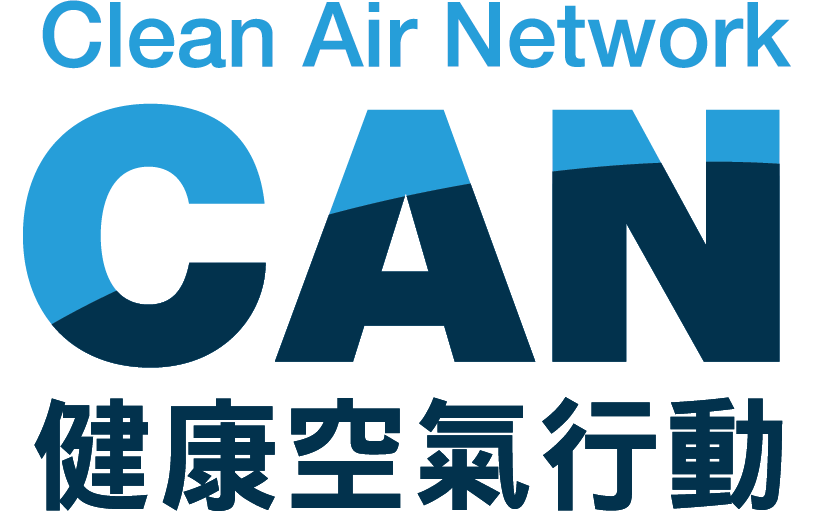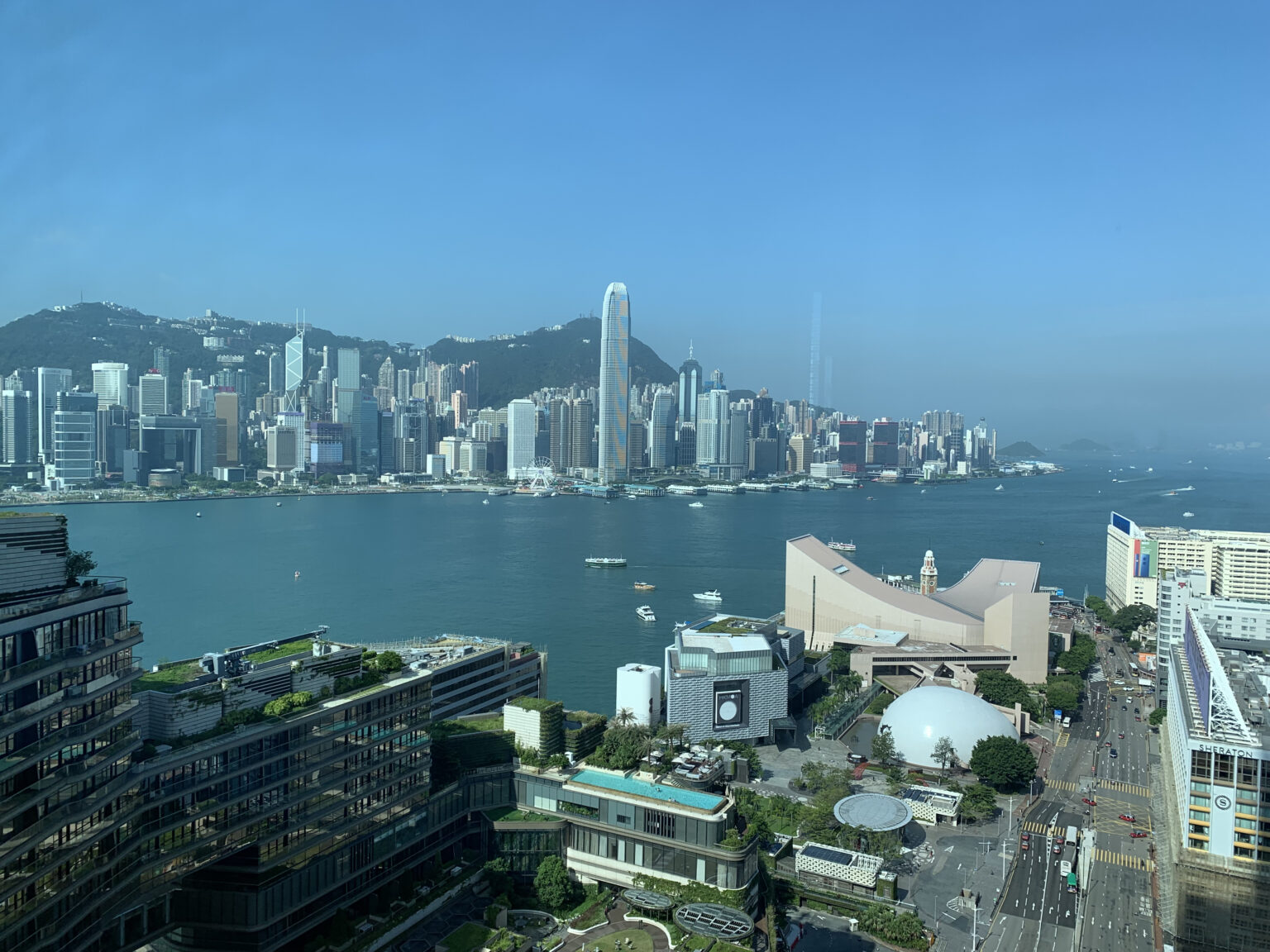
2022 Annual Air Quality Review
Pollution Levels Dropped Yet Remain Unsafe
Rising Ozone Concentration Hit Record High
Clean Air Network (CAN) analyzes air quality data from the Environmental Protection Department’s monitoring stations every year to understand local pollution trends. In 2022, the annual average concentrations of three major pollutants, including nitrogen dioxide (NO2), PM10 and PM2.5, all decreased, but still exceeded the safety standards recommended by the World Health Organization. In particular, roadside NO2 concentration exceeded by 540%. It is estimated that unsafe pollution levels in 2022 had caused 3,516 premature deaths and an economic loss of 41.9 billion HKD.
Meanwhile, ozone (O3) concentration continued to rise. The annual average concentration recorded at general monitoring stations was the second highest on record, and that at roadside monitoring stations even reached a historic high, indicating that current policy measures are insufficient to curb ozone pollution.
1. Major pollutants reduced except for ozone
In general, Hong Kong has seen an improvement in air quality in 2022. Annual average concentrations of NO2, PM10 and PM2.5 at general and roadside monitoring stations all dropped by over 10% (see Table 1), reaching a lowest point on record. However, ozone concentration was on the rise – it rose by 4% at general stations and by 6% at roadside stations.
Table 1: Annual average concentration of major air pollutants (μg/m3)
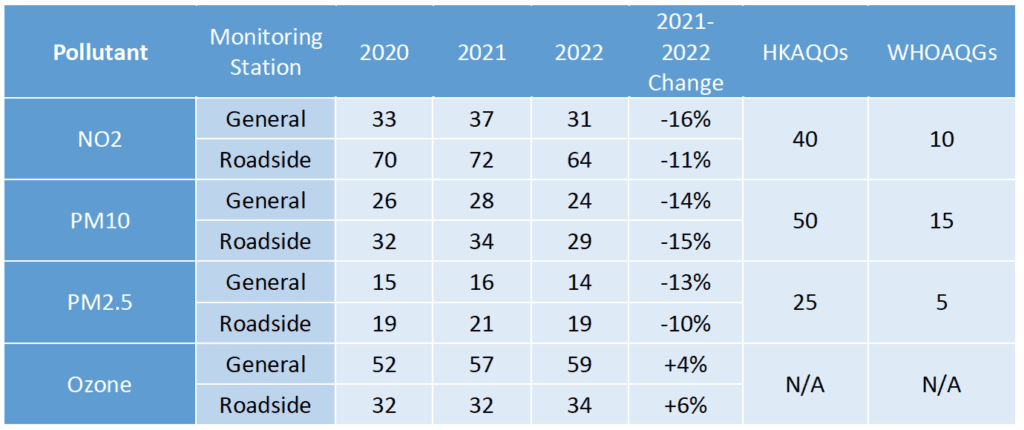
2. Far from WHO standards, roadside NO2 exceeded by 540%
Although the concentrations of NO2, PM10 and PM2.5 dropped, they are still very much above the WHO Global Air Quality Guidelines (WHOAQGs) safety standards (see Table 2), with the most significant being roadside NO2, which exceeded by 540%, and roadside PM2.5, which exceeded by 280%.
Air pollution inflicts health and economic costs on society. As estimated by the Hedley Environmental Index by the School of Public Health of the University of Hong Kong, the failure of Hong Kong’s air quality to meet WHO standards in 2022 had led to 3,516 premature deaths, 4,760,559 doctor visits, 218,679 hospital bed days, and a total economic cost of 41.9 billion HKD.
Table 2: Comparison between annual average concentration of air pollutants and WHOAQGs

Chart 1: Annual average concentration of NO2
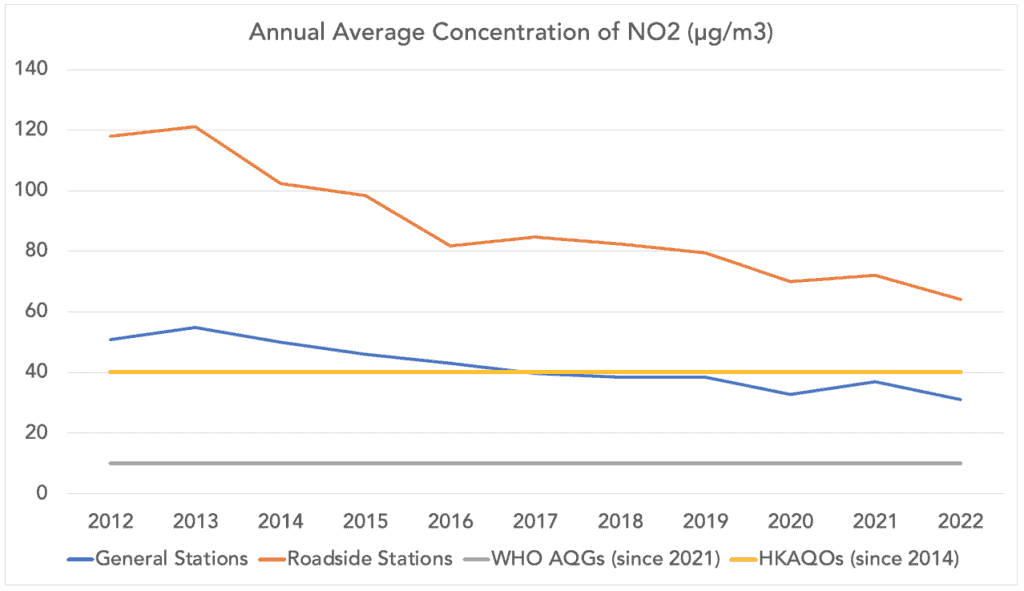
Chart 2: Annual average concentration of PM10

Chart 3: Annual average concentration of PM2.5
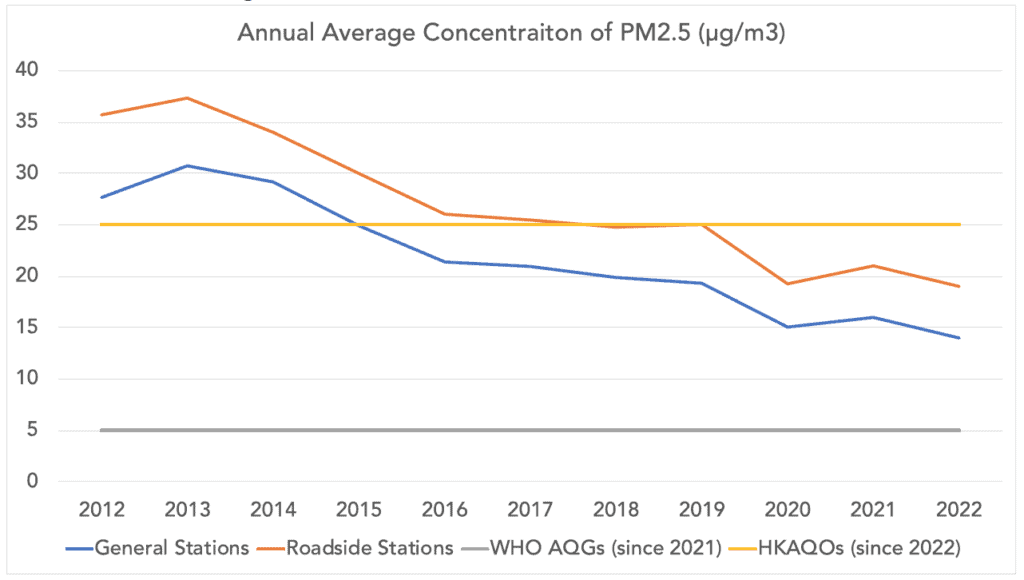
3. Ozone rising trend uncurbed
After a slight drop in 2020 at the beginning of the pandemic, the annual average concentration of ozone continued to increase in two consecutive years. In 2022, ozone concentration at general monitoring stations was 59 μg/m3, increased by 4% compared to 2021, which is the second highest on record, close to the peak in 2019 (60 μg/m3). On the other hand, the record at roadside was 34 μg/m3, which rose by 6% to a historic high.
Ozone is a regional issue. Tap Mun general monitoring station, of which the data reflects regional emissions, recorded an annual average ozone concentration of 76 μg/m3 in 2022, slightly decreased from the previous year (77 μg/m3). Nonetheless, ozone pollution penetrates communities across the city. Many of the general stations recorded a rise in ozone levels, with Kwai Chung (+12%), Central/Western (+11%) and Shatin (+11%) having the largest increase. Ozone concentration at the roadside stations in Central and Causeway Bay also increased by 12% and 10% respectively.
Chart 4: Annual average concentration of ozone
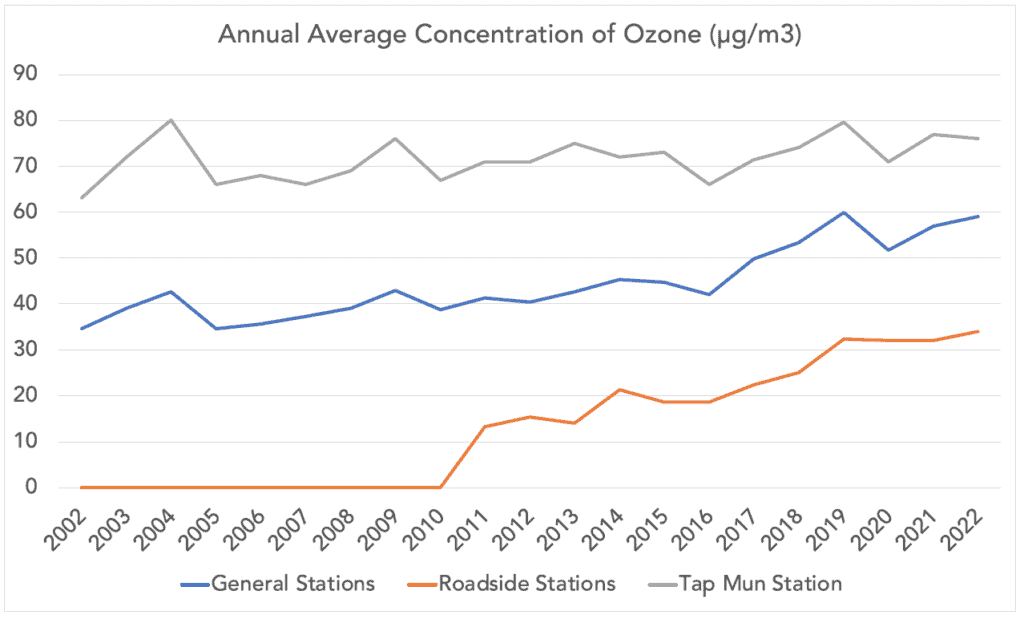
4. Air quality worst in Tuen Mun and Kwun Tong
Among the 15 general monitoring stations, Tuen Mun had the highest annual average concentration of PM10 (32.2 μg/m3) and PM2.5 (18.3 μg/m3), while Kwun Tong had the highest concentration of NO2 (44.8 μg/m3).
In 2022, the concentrations of NO2, PM10 and PM2.5 at almost all the general stations dropped, except for Yuen Long, which recorded a 6% increase in PM2.5 level, from 17.4 μg/m3 to 17.6 μg/m3.
Table 3:Annual average concentrations of major pollutants by district (μg/m3)

5. Analysis and recommendations
1) More aggressive measures needed to achieve clean air and decarbonization goals
The reduction in NO2, PM10 and PM2.5 annual average concentrations reflects the effectiveness of current measures, yet they are inadequate to bring Hong Kong’s air quality close to WHO standards. Moreover, as the pandemic comes to an end, social and industrial activities in Hong Kong and the mainland resume, pollution and emissions are expected to increase.
Against this backdrop, the government ought to carry out more policy measures, such as expansion of green transportation, electronic road pricing, extension of low emission zones, pedestrian and bicycle friendly policies, tightening marine vessel emission standards, and adoption of clean energy, so as to achieve its goals of having Hong Kong’s air quality on par with international cities by 2035, and attaining carbon neutrality by 2050.
Roadside NO2 pollution, which mainly came from car emissions, surpassed WHO standards by 540%. CAN has been advocating for a swift transition to zero-emission transportation, especially commercial vehicles, since they are responsible for over 90% of the local vehicular emission of NOx. However, due to the lack of financial support and infrastructure, the transition progress has been slow. Even though the government vows to introduce about 700 electric buses and 3,000 electric taxis by 2027, those only account for 12% and 16% of the local bus and taxi fleets respectively. In contrast, Shenzhen has already electrified all its buses and taxis by 2019. CAN urges the government to lay down a clear timeline for zero-emission commercial vehicles without delay.
2) Tighten AQOs to meet WHO standards
A new round of review of Hong Kong’s Air Quality Objectives (AQOs) is currently in progress, scheduled to be completed by this year. CAN believes the AQOs should be further tightened, with a clear aim to meet the WHOAQGs as soon as possible, in order to safeguard public health.
3) Immediate plan required to reduce ozone pollution
Ozone pollution has been worsening over the years. As the number of electric vehicles is expected to increase, emissions of nitric oxide (NO), which could scavenge ozone, will decrease. Ozone concentration in urban areas is thus anticipated to further increase, but policies to react to the situation remain absent.
The government claims to have embarked on various studies on ozone, including setting up a supersite at Cape D’Aguilar in 2017; the study on “Photochemical Ozone Pollution in Greater Bay Area and Characterization of Regional and Super-Regional Transportation of Ozone”, to be completed in 2024; the Guangdong-Hong Kong-Macao Greater Bay Area Air Quality Laboratory and Meteorological Monitoring Supersite, which costs at least 261 million HKD, will also monitor and analyze ozone formation, but will only begin full operation in 2027. The impact of the above measures remains uncertain, while ozone pollution keeps mounting. As public health is at immediate risks, CAN urges the government to implement local and regional solutions to reduce ozone emissions at the earliest opportunity.
